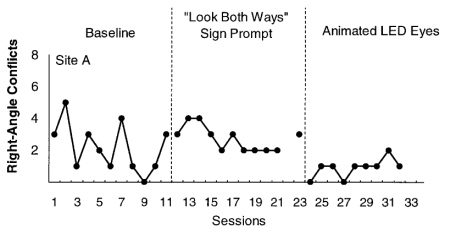
1. List the components of Skinner’s three-term contingency.
2. What is the difference between overt and covert antecedents, and immediate and distant antecedents?
3. Define stimulus control.
4. What are the components of stimulus discrimination training?
5. What is (stimulus) generalization?
How can _______ behaviour be affected by changing environmental stimuli?
(Van Houten & Retting, 2001)
- stop signs modified at intersections at which there had been at least 4 crashes in the past 3 years
- baseline data collected
- measures:
• % of vehicles coming to a complete stop
• % of drivers looking right before entering the intersection
• number of “right-angle _________”
- behavioural treatment program: A-B-C design
• installed sign reading “LOOK BOTH WAYS”
• installed an LED display with animated ____ looking left and right
- videotaped 6,300 vehicles over a 3-month period
- results: LED display affected driving (sign had little effect)
• complete stop increased from 55% to 77%
• looking right increased from 79% to 85%
• right-angle _________ decreased from 4 to 1.4
The _____-____ contingency (Skinner, 1969):
- also known as the “ABCs” of behaviour
- in the presence of a particular antecedent cue or signal (a ________), a specific behaviour will be followed by a certain consequence
antecedent → behaviour → consequence
e.g., phone rings → you answer it → you get to talk to your girl/boy friend
Antecedents:
- include the stimuli, events, or situations that precede a behavioural response
- these provide the _______ in which consequences may occur
- all antecedents are stimuli
- types of antecedents:
• _____ antecedents: stimuli directly observable with your senses
e.g., you hear your phone ring → answer it
• ______ antecedents: internal experiences; not open to observation by others
e.g., you feel hungry → get a snack
• _________ antecedents: occur right before--or overlap with--behaviour
e.g., fire alarm goes off → leave the building
• _______ antecedents: stimuli (often covert) that precede the behaviour by a long time; also can affect behaviour for a long time
- medication effects, health status, history of abuse can influence current behaviour
e.g., person abused by spouse → avoids long-term relationships many years later
- every antecedent is overt or covert, and immediate or distant
e.g., feeling hungry is covert and immediate
________ _______ is the extent to which an antecedent stimulus can influence performance of a specific behaviour
- when a stimulus exercises a high degree of stimulus control, the behaviour is highly likely to occur in the presence of the cue
e.g., every time you hear your ringtone you grab your phone
- stimulus class: related stimuli that have the same effect on behaviour
Stimulus ______________ training: administering a certain consequence for a specific behaviour when a particular stimulus is present, but not when another stimulus is present
• in the presence of the discriminative stimulus (SD), the behaviour is reinforced
• in the presence of any other antecedent stimulus (SΔ or S-delta or “ess delta”), the behaviour is not reinforced
• Holland and Skinner (1961):
- pigeon placed in operant conditioning chamber
- when red disk was illuminated and the pigeon pecked it, food was delivered
red disk (SD) → peck disk → food
- when green disk was illuminated and the pigeon pecked it, no food was delivered
green disk (SΔ) → peck disk → no food
• real-world example:
- driving a car, approaching an intersection
red traffic light (SD) → press brake → safe!
green traffic light (SΔ) → press brake → not safe?
• real-world situations typically involve ________ antecedents
e.g., passing a slow-moving vehicle depends on 1) the vehicle, 2) dashed centre line, 3) oncoming traffic, 4) weather/road conditions, etc.
• three-term contingency notation:
SD → R (response) → SR (reinforcing stimulus)
SΔ → R (response) → (nothing)
e.g., red traffic light (SD = discriminative stimulus) → press brake (R = response) → safe! (SR- = negative reinforcement)
Stimulus generalization: occurs when a stimulus similar to the SD also produces the behaviour
- generalization ________: stimuli most similar to the SD produce the strongest response
Guttman and Kalish (1956): pigeon pecks in response to wavelength
Stimulus ___________: two or more different stimuli that can be used for the same purpose
e.g., the quantity four can be written as 4, four, or IV
Can participants learn to discriminate artists?
(Watanabe et al., 1995)
- participants were reinforced if they responded to 10 paintings by impressionist Claude Monet (SD)--but not if they responded to 10 paintings by cubist Pablo Picasso (SΔ) (or vice-versa in the other group)
- results:
• participants showed stimulus generalization, responding to Monets they had never seen before
• participants showed discrimination, ignoring never-before-seen Picassos
• but participants also showed generalization by responding to paintings in similar art styles (Cezannes and Renoirs, who were Impressionists like Monet)
• and further discrimination by ignoring paintings in different art styles (Braques and Matisses, who were Cubists like Picasso)
- the participants were _______